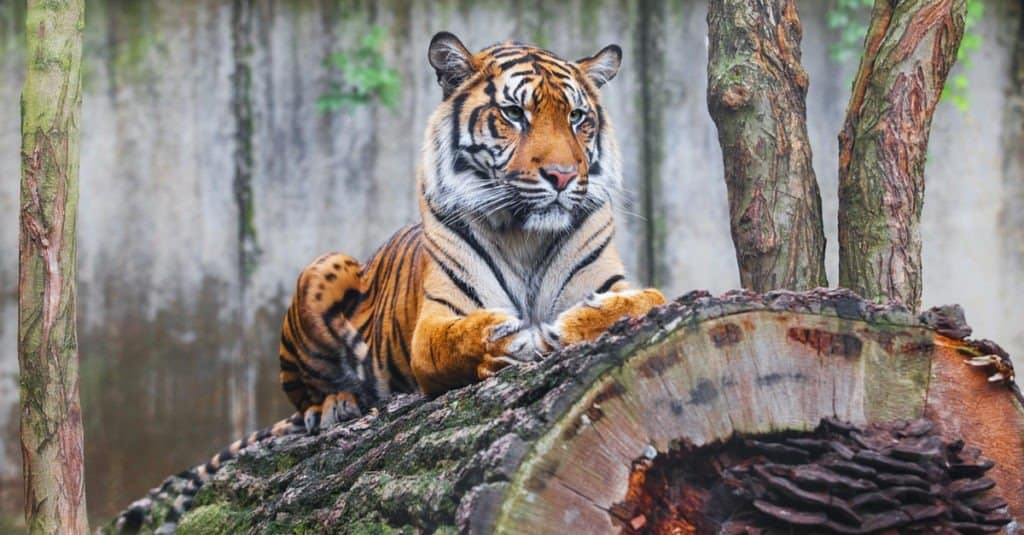The country of Indonesia spans a distance larger than that between Los Angeles and New York City, encompassing roughly 18,000 islands. Among these, only about 6,000 are inhabited by humans, while the others host some of Earth’s most diverse animal life and incredible landscapes. This cradle of biodiversity contains countless endangered species, many of which are disappearing each year. Indonesia consists of five main islands: Kalimantan, Western New Guinea, Celebes, Java, Moluccas, and Sumatra. Sumatra is the largest Indonesian island and the sixth-largest island in the world. It is the home of the rarest tiger on Earth, the Sumatran tiger.
The Impact of Poaching on Sumatran Tigers

While some argue that holding Sumatran tigers in captivity is unethical, others believe it is necessary.
©Marten_House/Shutterstock.com
The world’s rarest tiger has experienced several hardships in recent years. Hunting is the largest and most prolific cause of Sumatran tiger deaths, accounting for nearly 80% of annual losses. Poachers have hunted them to near extinction, driven by the desire to profit from selling their body parts. Currently, they are classified as Critically Endangered on the IUCN Red List of Threatened Species.
The skin and teeth of Sumatran tigers are a common exotic trophy item, while their whiskers and bones are occasionally used as ingredients in Chinese traditional medicines. All parts of these tigers fetch high prices on the secondhand market. Unfortunately, protection laws often fail to deter hunters who are driven by the potential for large profits.
Deforestation and Human-Tiger Conflict

As the Sumatran tigers’ natural territory shrinks, the risk of human-tiger conflict increases.
©I, Kevin1243, CC BY-SA 3.0, via Wikimedia Commons – License
In addition, Sumatran tigers have also been slowly losing their natural habitat due to the palm oil, paper, and coffee industries. Illegal deforestation is common throughout the regions where many Sumatran tigers are native. Just like the hunters, legal ramifications do not scare off those destroying the forest. Their desire for profit remains too high, and the punishment for being caught is not strict enough. The involvement of many high-ranking politicians in the illegal logging industry further complicates the fight against the destruction of their habitat. The remaining 20% of Sumatran tiger deaths are attributed to this activity.
Human-tiger conflict is positively correlated with increased deforestation. Consequently, the smaller the Sumatran tigers’ habitat gets, the more likely they are to have a confrontation with human populations. When humans set up farms or communities in the wake of cleared-out forests, they leave themselves at high risk for tiger attacks. As the forest shrinks, the frequency of encounters staggers greatly, forcing conservationists to take immediate action. These events have left the Sumatran tigers’ total population devastated. Estimates indicate that only 400 still exist in the wild, with another 200 living in captivity. The Javan and Balinese tigers have since gone extinct, leaving the Sumatran as the last remaining tiger species native to Indonesia. The preservation of this species is paramount, and time is running out.
How Conservationists are Fighting Back

Sumatran tigers can sleep for up to 18 hours a day.
©Linda George/Shutterstock.com
Due to the gravity of the situation, protection efforts are at an all-time high. In response to this crisis, conservationists are employing several methods to help slow the disappearance of these beautiful tigers. One such preserve at the forefront of Sumatran tiger conservation is the Tambling Nature Preserve, located at the southwest tip of Sumatra. Upon its founding, any human communities that settled in the area were relocated off-site. They began reforesting immediately, which allowed wildlife to thrive, and animals such as buffalo and deer enjoyed a boom in their populations. As human-tiger conflicts rose, it became clear that trapping and relocation were necessary. However, the question remained: where would be safe enough? The Indonesian government saw Tambling Nature Preserve as the answer. For 15 years, tigers have been rehabilitated and rereleased into the wild there.
Another one of the strategies to increase the Sumatran tigers’ numbers is breeding in captivity. Some argue that this is unethical, as these tigers cannot live in the wild where they belong. Despite this, it may just be a necessary evil to keep the species alive. Newborn Sumatran tigers are much like human babies, requiring constant feeding and attention. Often, multiple veterinarians watch newborn cubs around the clock, monitoring them for any potential signs of illness. Each additional tiger cub brought into the world provides additional genetic diversity, and strengthens hope for the future.
Outlook for the Future of Sumatran Tigers

Sumatran tiger cubs usually stay with their mothers for two to three years.
©iStock.com/slowmotiongli
The effectiveness of the strategies employed varies depending on several factors, such as government support, financial backing, and widespread awareness. Although it may seem like an uphill battle, conservation efforts are having a positive effect on the numbers of Sumatran tigers. Without human intervention, rehabilitation, and relocation, it is likely that the Sumatran tiger would have already suffered the same fate as their Javan and Balinese counterparts.
The photo featured at the top of this post is © Marten_House/Shutterstock.com
Thank you for reading! Have some feedback for us? Contact the AZ Animals editorial team.






